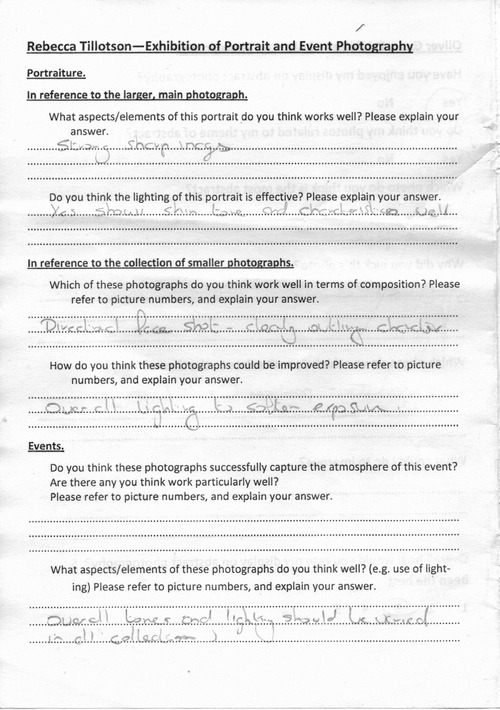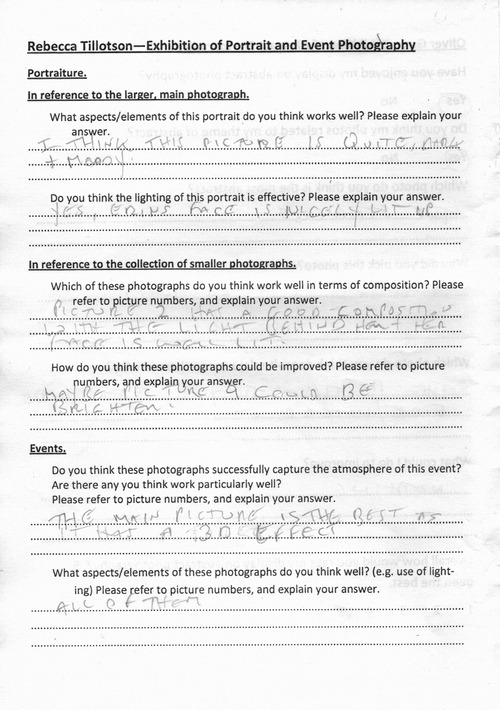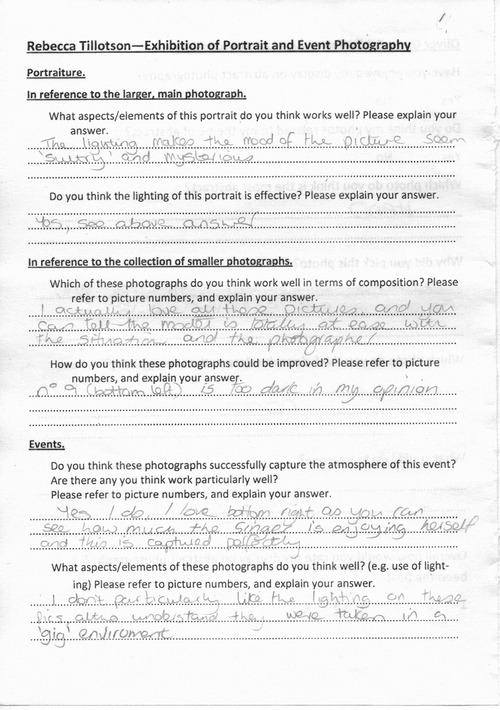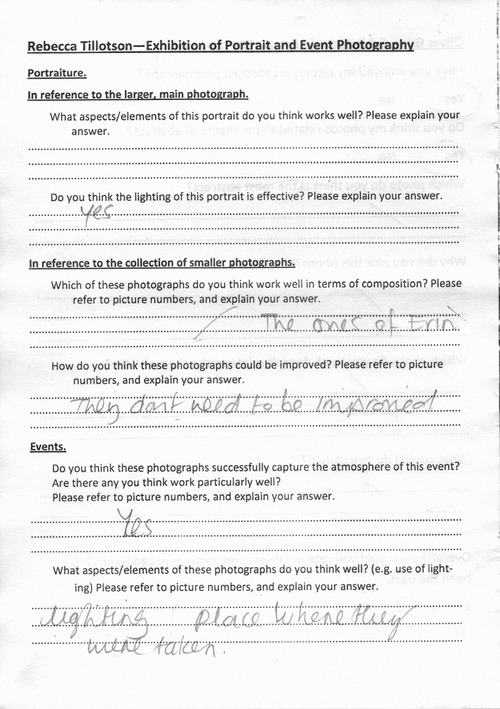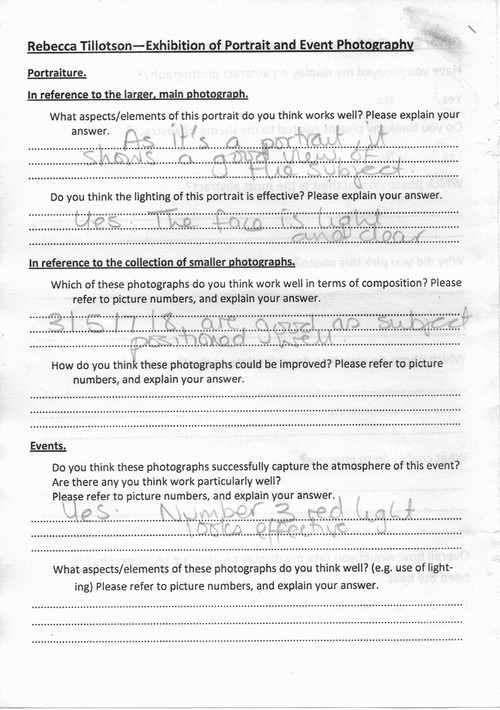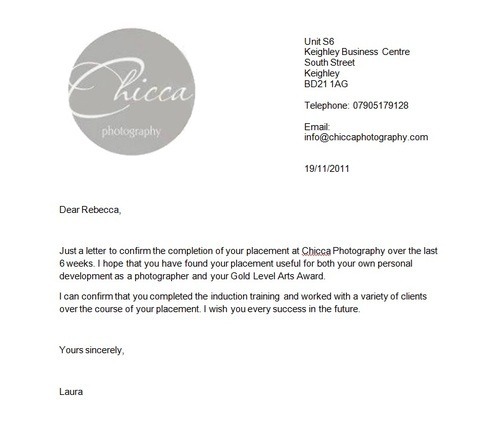Text
INTRODUCTION
-
My tasks for Unit 1 of my Arts Award are:
-
Establish main art form.
Decide upon my challenge.
Create an action plan for my challenge.
Work with a practitioner and/or peer.
Research my challenge art form/genre.
Create an original piece.
Share the original piece.
Collect feedback from others.
Reflect on what I learned.
-
0 notes
Text
SA: AIMS AND INTENTIONS
-
In this unit I intend to research and develop my understanding of portrait and live music photography by looking at various artists within each field and also gathering information on what other professionals and experts advise is the best way to succeed in each of these fields. During this unit I also intend to develop my own skills by taking part in volunteer placements under more experienced practitioners.
-
0 notes
Text
SA: ACTION PLAN
-
Start Challenge: To learn event/portrait photography
-
30/09/2011: Writea letter requesting work within school (events)
-
10/10/2011: Write a letter requesting work with a professional photographer (Portraits)
-
1/11/2011: Fully research event and portrait photography
-
15/11/2011: Complete several photoshoots giving a range of event/portrait photographs
-
20/11/2011: Decide how I will present my outcomes
-
Finish: Finished exhibition
-
0 notes
Text
SA: STYLE AND FORM RESEARCH
-
Portrait photography/Portraiture.
-
A field of photography in which the face/facial expression is the main focus. The aim is to capture the likeness, personality, and even the mood of the subject.
-
Although the face is of course prodominant, the entire body and/or background may be included.
-
Portraits are not typically just a snap shot, but a carefully constructed image of a person in a still position, and more often than not, the person is often posed to be looking directly at the camera.
-
Unlike most other photography fields, the model(s) in the portrait are often from a non-professional background, and in my opinion this adds more realism to the photograph, as there is little or no fakeness to their expression.
-
Portraits taken of families to commemorate special occasions, graduations or weddings, can either be produced professionally or vernacular (by an amateur) and are more likely intended to be for private viewing rather than to be seen by the public eye, unless of course, said portraits are taken for a specific reason, e.g. for fine art portraiture, commercial portraiture, or promotional portraiture (found on a book jacket (to show the author of the book))
-
-
Events/Live music photography.
-
A field of photography in which a large group of people are shot, and can include anything from football matches to University Seminar.
-
More often than not are candid shots as it aids in capturing the atmosphere of the event.
-
Unless used for promotional material, it is highly unlikely that the people featured in the events images will have any sort of professional background, and it is often members of the public captured.
-
In terms of live music photography, almost all professionally captured images are taken for publication purposes, be it for advertisement for the band or images for a magazine article, it is not often that the images will be taken with no useful purpose.
-
0 notes
Text
SA: PRACTITIONER RESEARCH
-
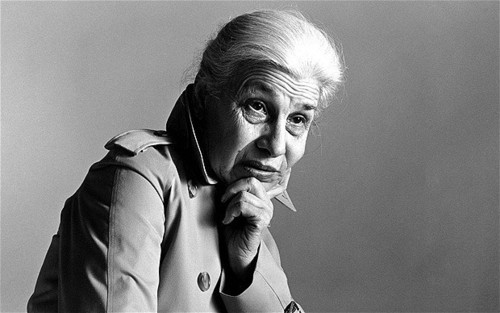
-
Eve Arnold
-
American photojournalist.
Mostly famous for her photographs of Marilyn Monroe.
Also photographed: Queen Elizabeth II, Malcolm C, and Joan Crawford.
Travelled around the world photographing in China, Russia, South Africa and Afghanistan.
-
-

-
Yousuf Karsh
-
Canadian photographer of American heritage.
One of the most famous and accomplished portrait photographers of all all time.
Most famous for his portrait of Winston Churchill.
Also famous for photographing Muhammed Ali, Albert Einstein, Audrey Hepburn and Pablo Picasso.
-
-

-
Philippe Halsman
American portrait photographer.
Most famous for his portrait of Albert Einstein.
Also famous for photographing Salvador Dali, Alfred Hitchcock, Judy Garland, Winston Churchill, Marilyn Monroe, and Pablo Picasso.
-
-

-
Adam Elmakias
American live music photographer
Most well-known for his work with All Time Low
Has also worked with Alternative Press, and bands such as Pierce The Veil, Of Mice and Men, Sleeping With Sirens, and A Day To Remember
-
-
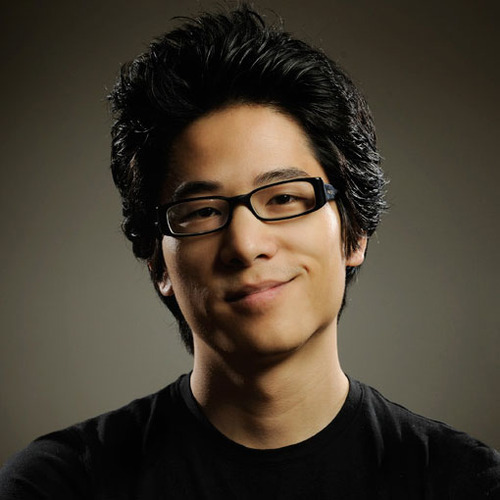
-
Todd Owyoung
American live music photographer
Has been known to work for magazines as big as Rolling Stone.
Also worked with the New York Times, SPIN, Billboard, Alternative Press, The Boston Globe, and has clients including Fuse TV, and Universal Music Group.
-
-

-
Ross Halfin
London based live music photographer
Most well-known for being the photographer of the first ever Kerrang! Magazine cover photo
Has toured with bands such as Iron Maiden, Metallica, Def Leppard, Kiss, Motley Crue, and I was also a tour photographer for Paul McCartney, George Harrison and The Who
-
0 notes
Text
SA: LOG OF PROGRESS
-
12th Dec 2012 – Planned This Day In History photoshoot
17th Dec 2012 – This Day In History live performance 8pm – 11pm
11th Jan 2012 – Planned photoshoot with Erin
17th Jan 2012 – Photoshoot with Erin 4pm – 5pm
25th Jan 2012 – Selected my images and photoshopped to a satisfactory standard
-
0 notes
Text
SA: EVIDENCE OF SHARING
-

-
This is a small selection of the images I presented as part of my exhibition:
-
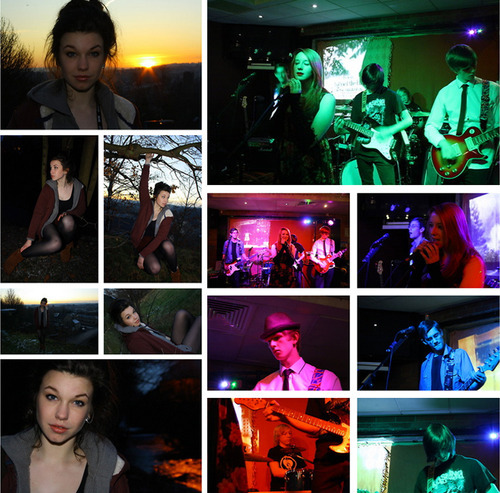
0 notes
Text
SA: REFLECTION
-
Please click ‘read more’ to read my reflection
-
When researching the necessary background information on my chosen art form, I used sources such as the internet, peers and other practitioners. Although my art form as a whole was photography, I chose to focus on two fields in particular – portraiture and music events. I started off by looking for photographers which had become particularly successful in these fields, for instance Philippe Halsman, who took a very famous portrait of Albert Einstein, or another example would be Andrew Kendall who is a famous concert photographer, who has photographed artists such as Amy Winehouse and Green Day.
-
Being an aspiring photographer myself, I also personally know a few portrait photographers, one of which agreed to let me sit in on a photoshoot she had planned and allowed me not only to take notes but also interact with the customers and experiment with her equipment, allowing me an improved understanding of the field.
-
I presented this research on an online blogging website named ‘Tumblr’ which allows me to individually identify each post I have submitted, thus allowing me to group similar research and experimentation within the same post. I chose this method because this is what I saw to be most suitable, it is easily accessible, and also easily modified, meaning I can add and subtract things as my research progresses.
-
I think just from looking at examples of famous portraits, it is easy to say that the skill required to produce such an outcome comes almost purely from the photographer, as the majority of the most well known photographs are from dated black and white film cameras, which means that there was little effects added or settings altered internally. In terms of concert photography much more in depth research was necessary, meaning I was required to physically search ‘how to be a concert photographer’ which lead me to a series of websites explaining step by step the complications of this field, and their best tips to overcome them, from this I learned that timing is key and also to be prepared with the correct, essential equipment in order to create the best results.
-
Although you wouldn’t initially make the connection between portrait, concert and also landscape (my original field of photography) there is one distinct link between the three, and that is settings. All three require extreme precision when it comes down to taking the photograph; surroundings are constantly changing, as well as the light source (even when doing indoor ‘shoots) which requires the photographer to be constantly ‘on the ball’ and able to instantaneously alter the camera in order to compensate for the lighting.
-
The reason I chose to do portraiture and concert photography for my arts challenge is because I feel these are the fields I am weakest in, and yet they are the ones I feel that would get me the furthest in terms of my career, so by challenging myself to improve and research how to become successful in these fields I intended the task to then encourage me to continue to improve outside of the course so I can eventually be confident enough to ‘put myself out there’ and put my skills to use.
-
Portrait photography is something which can be in quite high demand at times, and by gaining firsthand experience with a practitioner and also making sure I have a complete understanding of the field, I feel that outside of the course such experience would be something that would make me stand out in comparison to other available photographers. Concert photography, although a very tough business to gain entrance to, I feel would be incredibly satisfying to perfect; when looking at existing photographs from famous photographers, it is easy to see that the key focus for such images is atmosphere – being able to capture the emotion of the band and crowd in a single image. It was made clear during my extensive research that with this field you very much have to start from the bottom and force your way up, but I think with the right dedication, to achieve such a thing would be incredibly rewarding.
-
Something I have always found difficult with portrait photography is confidence, not in my work, but in myself. I am not a very outspoken person, and therefore I often find myself incapable of instructing people into the poses I envisage for the image which I feel directly effects my outcomes because I leave the model unsure as to what it is that I want them to do meaning the final images do not turn out how I imagined them to be. Although this is a major problem for such an outgoing field, I think that by identifying that I struggle with the authority of the job, it allows me to then attempt to change that and improve my working style.
-
On the other hand however, when taking my concert images I found the only problems I came across were altering my settings to compensate for the lighting and doing it fast enough without me missing any great compositional opportunities. Other than this minor problem I found the rest of the experience to be quite simple, I was confident in moving around the crowd and trying out different angles and also different focus points (i.e. alternative members of the band).
-
As a group for this challenge we came to the decision of collecting our feedback in a small booklet that the viewers would fill out, which I think worked out rather successfully, although my personal questions seemed to be too technically worded for most of the people who were unfamiliar with photography terms. This aside, I did manage to collect a few pieces of useful feedback, which informed me that the viewers thought my use of natural light in my portrait series was very effective, although some thought I may benefit from trying different sources and/or settings in order to change the softness of the expressions. The only useful feedback I received in terms of my concert series was to maybe take some photographs of the audience in an attempt to capture the atmosphere from them. In order to present this feedback I plan on scanning a few of the useful forms and uploading them to my ‘Tumblr’.
-
I think if I was to do this challenge again, I would probably really push myself by focusing on concert photography and then getting in contact with a popular venue; allowing me the opportunity to capture the concerts of small famous bands, rather than the easier option of a local band in a small pub.
-
0 notes
Text
SB: STATEMENT OF INTENT
-
For my placements I intend to volunteer at two different locations, the first being Hipperholme and Lightcliffe, where I intend to spend my time photographing various fundraising events within my placement, as well as the dress rehearsals for the schools performance of Dracula Spectacular, which will allow me to get a feel for capturing the atmosphere of a form of live music, aswell as giving me my first opportunity at handling stage lights. My second placement will be working with a professional portrait photographer, Laura Sunderland, who I will shadow during her existing appointments, as well as being taught some brand new skills such as how to use a lighting rig and using different hoods on said rig to create different effects, I also intend how alternating my angles will improve the feel of my images.
-
0 notes
Text
SB: EVIDENCE OF ACCEPTANCE TO PLACEMENTS
-
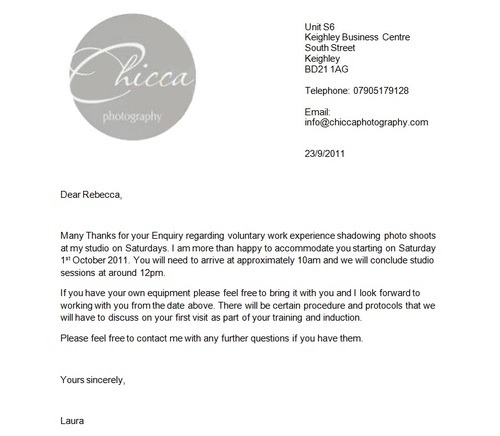

-
0 notes
Text
SB: EVIDENCE OF CAREER PATHWAYS RESEARCH
-
Photography Fields:
-
Photojournalism, Documentary, Action, Macro, Micro, Glamour, Aerial, Underwater, Art, Portraiture, Wedding, Advertising, Travel, Landscape, Abstract, Promotional.
-
I want to look further in to:
Photography fields surrounding the music industry (photojournalism, event, promotion)
-
Photojournalism: These are a list of instructions found on ‘ehow.com’
-
Invest in good equipment, such as a high-end Nikon or Canon film or digital camera. You’ll also need different lenses and flashes or other types of lighting gear.(1)
-
Attend photography or journalism school(2). Develop your eye, improve your style and technique, and make contacts in the field. It’s a good background whether you want to work for a community newspaper or travel the world as a freelance photographer.
-
Get an internship with a magazine or newspaper. This gives you real-life experience and gets you published, and it can turn into a full-time job. Some people have several internships(3) before they find permanent work.
-
Develop a portfolio(4) that showcases your expertise with a wide range of subjects. It should include everything from one-shot car crashes to photo essays about people’s lives. Most newspapers and magazines want to see published work, but a student portfolio may get you an internship or entry-level position. You’ll work your way up from there.
-
Learn how to scan prints or download images from your camera(5), depending on whether you use a film or digital camera. Get training on image editing software such as Adobe Photoshop(6).
-
Know how to think on your feet. News events happen fast and can pack an emotional wallop. Your ability to stay calm and make quick decisions will greatly impact your success.
-
Go for the best story rather than settling for the easy shot. Just as a reporter would do, look for balanced reporting and seek out opposing viewpoints of the stories you cover.
-
Prepare yourself for physical and mental challenges. You’ll carry heavy equipment(7) in all kinds of conditions. You never know whether you’ll cover a storm, a robbery or an accident. Some photojournalists work well even in dangerous (sometimes lifethreatening) situations and are assigned to cover wars, regional conflicts and other hot spots around the world.
-
Hold up under pressure and get your work in on time. News editors can get pretty touchy when they’re on deadline.
-
Click read more at the bottom for footnotes on the above information.
-
The following information was taken from http://www.myjobsearch.com/careers/photographer.html :
-
Responsibilities
-
Photographers are crucial in providing visual illustration for different purposes and it is said that a picture tells a thousand words. It is remarkable that the language of photography is somewhat aggressive (shoot, capture and take are the most commonly used terms), something which touches on one aspect of the job as they hunt for new images, with the photographer trying to best position themselves in order to find special scenes or moments in the world.
However, it is also true that photography is never merely neutral or objective, and pictures are always produced in quite an active sense: photographers mix the basic subject material with technical and creative insight to produce an image, and then exploit the commercial value of that product.
-
-
Qualifications
-
Qualifications in photography help to provide a solid understanding of photography and technical practice. Many people complete degrees in photography or shorter courses at art colleges before starting work, covering photography in general, vocational photography, photographic processing and other related subjects. Both full and part-time courses are available and include:
-
City & Guilds certificates
BTEC HNDs
Foundation degrees and courses
Full university degrees
-
Some of these courses are more demanding in terms of qualifications, and may require relevant A-levels, GCSEs or a prior foundation course. The British Institute of Professional Photography (BIPP) Professional Qualifying Examination (PQE) is well-respected and the organisation also offers good opportunities for networking with a mentor system to help new photographers. For more information visit their website: http://www.bipp.com/
-
Jobs in photojournalism, working for a newspaper or magazine, may require a specific qualification recognised by the National Council for the Training of Journalists (NCTJ) - see website below for further details: http://www.nctj.com/
-
Further options for qualification include the NVQ in Photo Imaging (levels 2,3 and 4) or more specialised short courses run by the BIPP or the association of photographers: http://www.the-aop.org/
-
-
Skills
-
Photographers need a keen visual eye to assess forms, colours, lighting and perspective. They also need a good technical and creative instinct to exploit basic subject material. Most photographers also require good people skills to get the best out of their subjects.
As most photographers work freelance basic business skills are useful, as is the ability to juggle commitments and schedules to maintain steady work in the face of a variable and changing working market.
-
-
Working Conditions
-
Photographers can work in a whole host of different locations, indoors and outdoors, at home and abroad, sometimes in glamorous, comfortable settings and sometimes in dangerous, hostile ones.
Working long or unsociable hours may come with the territory and even studio work can be hot and arduous, but for the most part photographers concentrate on producing the best photo possible, whatever the situation, and the working conditions are something most people enjoy.
-
-
Experience
-
Experience is important and as a photographer's portfolio is evidence of their best work this is something that should be established at the earliest possible stage and then improved.
After gaining formal qualifications it is essential to build contacts and experience and the best way to do this is by becoming a photographic assistant, helping a professional photographer on shoots with everything from lighting to keeping clients happy.
Many people work for 3-5 years as an assistant before even beginning to work independently so it is important to be realistic about the time and commitment required from the job.
-
-
Employers
-
Major employers do exist in photography but mainly only in specialised, individual areas such as fashion or nature, or in the growing business of library or archive projects. The biggest general employers are major newspapers, magazines and websites.
-
-
Career Progression
-
As most photographers work freelance the standard career path is to specialise in one kind of photography and start building a reputation for good work in this field and a business along with it. Getting work published and winning awards is a good means to this end.
-
-
Photojournalism:
(1) A starter kit for a serious photojournalist would consist of a Professional SLR body, a wide angle lens, a zoom lens, along with a flash unit and a sturdy tripod. Also, think of always having spare batteries and storage.
-
(2) There are plenty of courses available in photography and journalism, available both online and offline, an example of these would be http://www.thephotographyinstitute.co.uk/ and http://www.lcmj.co.uk/
-
(3) Another way to gain experience within the photojournalism career would be to go hands on and try your efforts with an internship, which when searched on the internet are easy to find, here is a good place to start: http://www.photographers.co.uk/html/photography-jobs.cfm
-
(4) There are many resources that will aid you when creating a portfolio, such as books, the internet and there are even computer programmes available to be bought with the sole purpose of helping you get the job you want.
-
(5) This is a really useful website I found when searching “How to scan or download photos from a digital camera” and it covers every step needed in order to complete this task. http://www.hp.com/united-states/consumer/digital_photography/take_better_photos/tips/download_photos.html. Another problem you may face is if you own a film camera, but it is simple to process these images, simply take the film roll to your local developing shop and they should be done the same day! Another solution would be to invest in a scanner specifically designed for film negatives, but these may require experience to use.
-
(6) There are plenty of resources available to efficiently learn how to use Adobe Photoshop just like the professionals do! For instance websites such as this one http://www.adobephotoshoptutorials.com/ which will cover most, if not all, the Photoshop skills you will need.
-
(7) Camera storage, photograph storage, lenses, filters, flashes and flash diffusers, tripods and the camera are just a few examples of the kind of equipment you will be expected to carry around with you on particular jobs, so be prepared!
0 notes
Text
SB: EVIDENCE LOG DURING PLACEMENT
-
28th September 2011
2 hours
Year 11 Devised Performance
-
1st October 2011
2 hours
Laura Sunderland (Portrait Photography)
-
19th October 2011
2 hours
Arts Award Evidence - Stage Crew
-
20th October 2011
4 hours
Hiplights Got Talent
-
17th November 2011
1 hour
Photos for Prospectus
-
18th November 2011
6 hours
Children In Need
-
22nd November 2011
5 hours
A level devised performance
-
0 notes
Text
SB: EVIDENCE OF PROFESSIONAL TRAINING
-
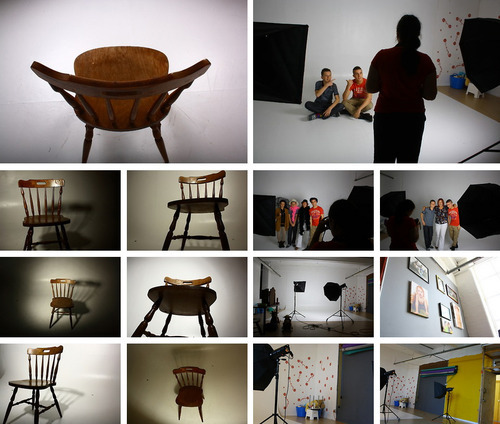
-
When working with Mrs Sunderland of Chica Photography, I was allowed to use her extensive lighting equipment in order to identify the different effects various lighting filters, settings and angles can alter the feel of photographs, even on subjects as simple as a chair. As well as having the opportunity to take some behind the scenes shots of her studio and her current clients.
-
0 notes
Text
SB: REFLECTION
-
Over the course of my placements, I feel I have learnt a lot in terms of working in the industry aswell as how to interact with the people I am working with. When working around Hipperholme and Lightcliffe High School for events such as Children In Need and their own talent show ‘Hiplights Got Talent’ I learnt how to adjust my settings and other camera features to suit the environments I found myself working in, and also how to alter the way I work around the people I found myself working with.
-
As well as this, when completing my placement at ‘Chicca Photography’ my development was more focused on the composition and interaction of the shots. For instance on one of the occasions when working with Laura Sunderland, the owner of the company, she was photographing a family who had a member diagnosed with autism, this was interesting to sit in on as it showed her capability to handle someone who needed extra care compared to her usual clients, as well as seeing how her studio was accompanying to several different age groups aswell as being child friendly, and divisibility in terms of backdrops and props.
-
Also when working at ‘Chicca Photography’ I was taught how to use an professional lighting rig, in terms of umbrellas and filters to create different effects with a single light, aswell as being taught what a different angles and compositions can make to a photograph. When practising with the rig we used a simple wooden chair as the subject, and yet managed to create a range of different images simply through lighting and angles.
-
I feel I have learnt a lot from working at both these places, and have developed skills that allow me to adjust how I work depending on the environments I find myself in. I also learnt how to interact with the different people I may come across, for instance when working at ‘Chicca Photography’ I found myself in the company of a family who had a young child with autism, so there were much more precautions and planning to this shoot as opposed to taking candid shots around Hipperholme and Lightcliffe.
-
0 notes

